In planning the battle for Luzon, MacArthur would have liked to surprise his waiting opponent. But Yamashita understood that Lingayen Gulf offered the only approach to the central Luzon plain, on which U.S. tanks could maneuver most effectively. It also had the best road and rail networks approaching Manila. Although he initially stationed 36,000 troops to cover the 22 miles of landing beaches, Yamashita conceded that U.S. naval firepower would just scythe his men down on the shoreline. And despite his public bravura, the Japanese commander knew that, with Halsey’s and Kinkaid’s U.S. fleets now masters of the sea, and Kenney’s planes filling the skies, the best he could really hope for was a holding action through a defense in depth to give the home islands time to prepare for the inevitable invasion.
So, in December 1944, he withdrew his men and headquarters, along with members of Tokyo’s puppet Philippine government, headed by the controversial President José Laurel, into the more defensible terrain around the Philippine summer capital of Baguio, 30 miles east of Lingayen and 150 miles north of Manila.
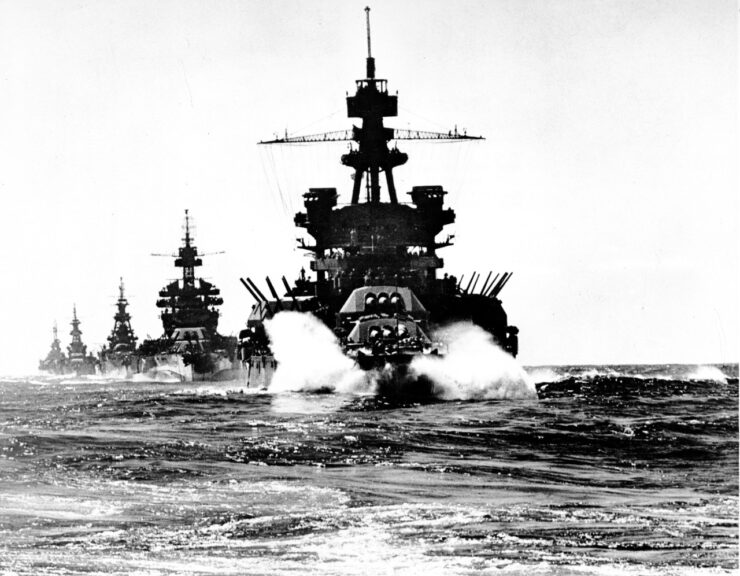
National Archives & Records Administration.
At dawn on January 9, 1945, code-named “S-Day,” the enormous U.S. fleet — the largest of any landings in the Pacific and equal to the American contingent at Normandy — lay into Lingayen Gulf and over 800 anchors splashed into the unusually calm waters. It was an awesome display of U.S. industrial might. At 0700, the big guns of some 70 battleships and cruisers roared, sending shells of all calibers whistling down onto what turned out to be undefended beaches. Beginning at 0930, the first of 175,000 troops of Gen. Walter Krueger’s Sixth Army waded ashore while Gen. Robert Eichelberger’s smaller Eighth Army was held in reserve.
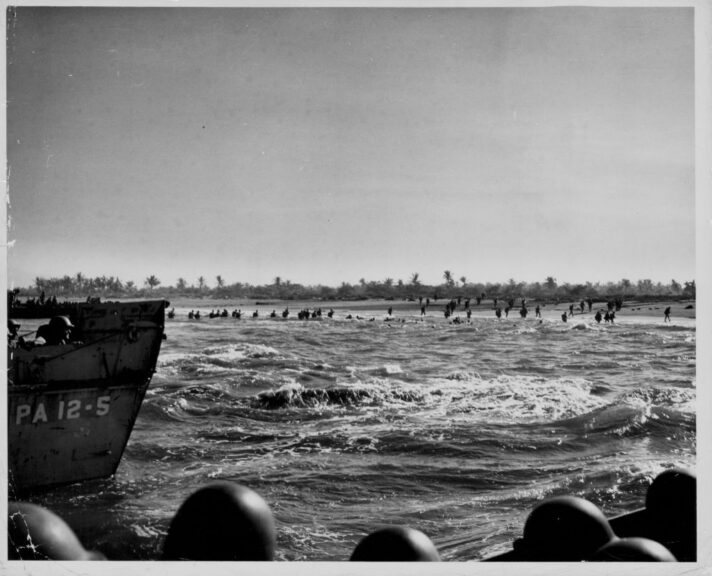
US Coast Guard/Getty Images
By the end of the day, the GIs would push eight miles inland. Only the occasional Kamikaze air and even suicide boat attacks, with sporadic artillery rounds warbling in from distant enemy gun positions, disturbed the otherwise smooth operations.
Once four of Kruger’s divisions made it ashore and began to press inland, MacArthur left his headquarters on the light cruiser USS Boise and headed in. Filipino peasants waving U.S. and Philippine flags joyfully greeted the Americans, while others raced ahead to spread the word that after over 1,200 days of Japanese rule, MacArthur had returned as promised, and their deliverance was finally at hand.
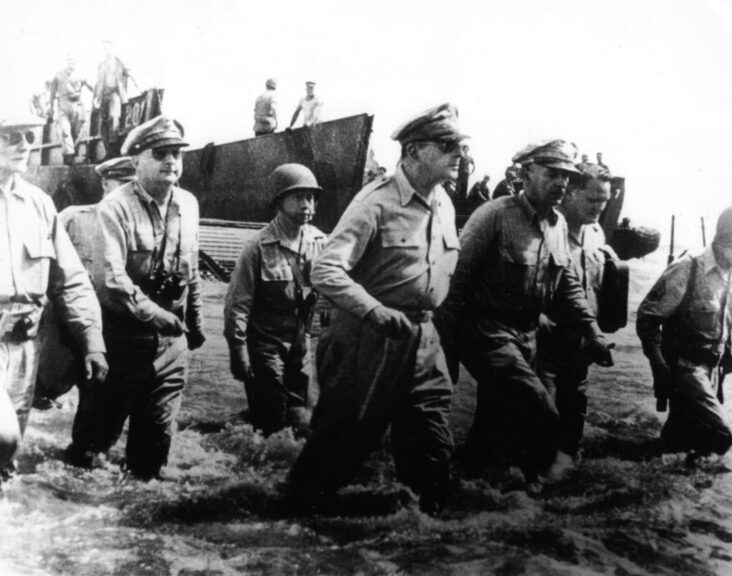
General Douglas MacArthur returns to the Philippines. Lingayen Beach (Philippines), in 1945. (Photo by: Photo12/Universal Images Group via Getty Images)
The central Luzon plain, the amphitheater in which Krueger’s army would be maneuvering, was roughly 40 miles wide and ran some 110 miles due south from Lingayen to Manila Bay. It was walled in on each side by high, rugged peaks blanketed under a thick layer of jungle vegetation. It provided ideal terrain for flying columns to advance quickly down the fine roads leading to Manila.
MacArthur had earned the epithet “Dugout Dug” on this island in 1942 when he rarely ventured from his headquarters in Corregidor’s Malinta Tunnel to visit the front lines during the bitter struggle to hold Bataan. But now the General was, quite literally, often out in front leading the GIs and tankers in their advance south. No doubt invigorated by the prospect of reaching his beloved city of Manila, he raced around the battlefield in his five-star-studded Jeep like a man decades younger. At one moment he could be found perched on the turret of a tank ascertaining Japanese positions. Other times up in a B-17 watching a parachute jump. Once when confronted by an enemy roadblock and a Nambu machine gun opened up, a flummoxed lieutenant shouted to him, “We’re going after those fellows, but please, sir, get down; we’re under fire!” Another time, while inspecting the lines of the 161st Infantry regiment, they were suddenly attacked by Japanese tanks and the lines buckled. In conduct reminiscent of his days leading the Rainbow Division over the top in the First World War, the highest-ranking general in the Pacific Theater personally rallied the troops who beat back the assault, earning him his third Silver Star.
Although courageous to the point of being reckless, there most likely was a method to MacArthur’s madness. It was to goad the cautious Krueger to move faster as he suspected, correctly, that Yamashita had opted to withdraw into the rugged mountains east of Lingayen to let the Americans come to him in time. Thus, he saw no need for caution. But Krueger feared a screaming host of Japanese might come charging down from the mountains to puncture his left flank, cutting him off from the beachhead to his rear, and, in Romulo’s words, “slicing him up like a pie.” But for a frustrated MacArthur, who justifiably feared Japanese reprisals against POWs and Filipino civilians alike, speed was everything. “Get to Manila!” he exhorted his commanders. “Go around the Japs. Bounce off the Japs. Save your men, but get to Manila!”
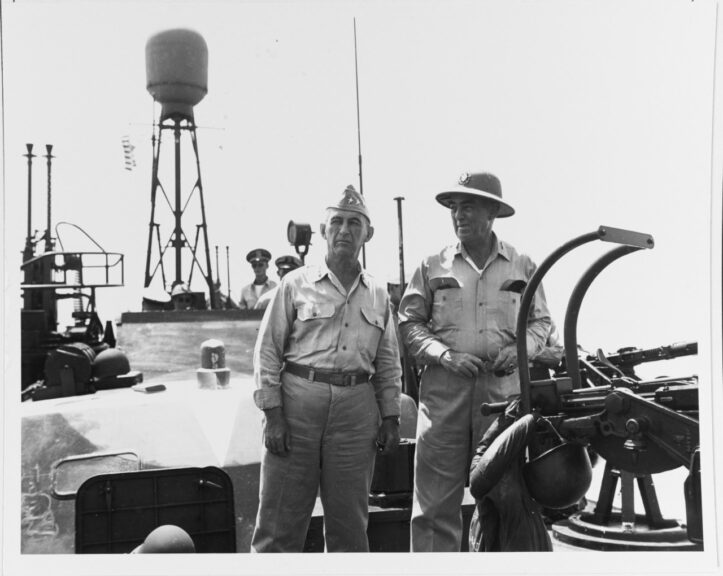
Vice Admiral Thomas C. Kinkaid, USN, Commander Seventh Fleet, and Lieutenant General Walter Krueger, USA Commander Sixth Army, on board PT-525, off Leyte Island, the Philippines, 23 October 1944. National Archives. Naval History and Heritage Command.
While Kruger was directing his Sixth Army in their fight to capture the enormous complex of runways and installations that made up Clark Field, his commander unleashed his reserves in a series of rapid thrusts elsewhere that confounded his Japanese opponent. Due to the Mindoro landing, Yamashita had to contend with the possibility of an attack from the south. So he sent part of his army to shore up defenses below Manila. As such, the landings in Lingayen caught every Japanese column in motion.
On January 31, MacArthur put a division of paratroopers from Eichelberger’s Eighth Army ashore at Nasugbu, 40 miles south of Manila. The landings were virtually unopposed as Col. Masatoshi Fujishige, upon whose shoulders the defense of the area had been entrusted, had placed his troops in defensive positions closer to Mindoro. In a scene reminiscent of the Allied advance through Holland, civilians cheered their American saviors, gifting them with food and spirits, and covering their vehicles in flowers until they resembled victorious Roman chariots.
Meanwhile, the General landed another corps at Subic Bay west of Manila above Bataan, and with minimal losses captured the valuable port of Olongapo while hitting the bewildered Yamashita with another regiment at Mariveles on the southern tip of the peninsula, trapping the Japanese troops in a double envelopment. Bataan, on which the Americans and Filipinos held out for months in 1942, fell in seven days. By the end of January, Manila was surrounded.
The most difficult Japanese nut to crack should have been the 5,000 Imperial soldiers stationed on the island bastion of Corregidor in the mouth of Manila Bay. With exquisite timing, paratroopers descended on the island’s “topside” while GIs stormed the “bottomside” beaches. After a week of fighting, the remaining defenders blew themselves up in the Malinta Tunnel. Although the Japanese lost twice their initial landing force taking the island in 1942, the Americans suffered fewer than 300 KIA (50 in the final explosion).
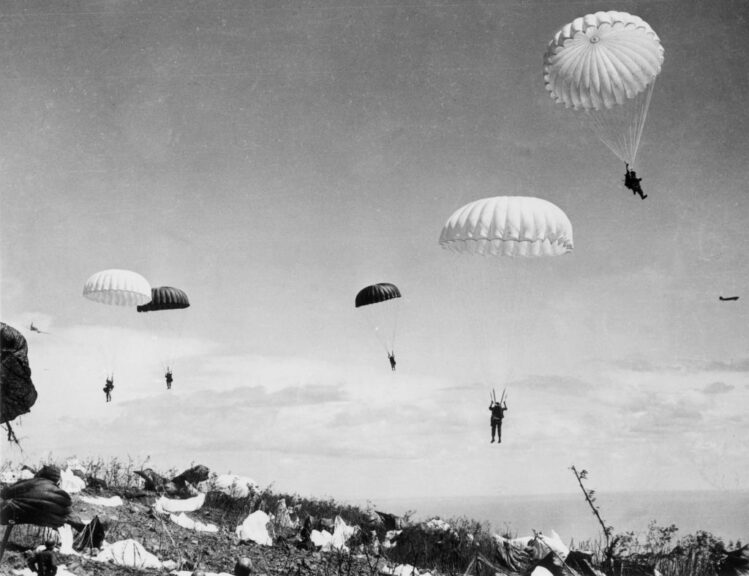
Central Press/Hulton Archive/Getty Images
The landings and subsequent race to Manila from all sides had been a remarkable strategic enterprise, which earned the ardent praise of no less an astute observer than Joint Chiefs Chairman Gen. George Marshall, who in his report would declare: “Yamashita’s inability to cope with MacArthur’s swift moves, and his desired reaction to the deception measures, combined to place the Japanese in an impossible situation.” The enemy, he went on, “was forced into a piecemeal commitment of his troops” which left the Agno River, a potential major defensive stronghold, lightly defended. MacArthur was able to neutralize Japanese numerical parity by compelling his opponent to split his forces and then scramble to attack with whatever units were in the zone of operations. The General himself would write in his memoirs with typical MacArthur braggadocio (though in this case justified) “Never had such large numbers of troops been so outmaneuvered…and left tactically impotent to take an active part in the final battle.”
JOIN THE MOVEMENT IN ’25 WITH 25% OFF DAILYWIRE+ ANNUAL MEMBERSHIPS WITH CODE DW25
With Clark Field finally in the methodical Krueger’s hands after heavy fighting, as well as engineers clearing out booby traps, the Japanese had sewn all over the installation, and the Americans from both the north and south were poised to enter the capital.
It was now early February and the 1st Cavalry, the vanguard of 100,000 Americans pouring down Luzon’s main highways while the rest guarded the beachhead, had reached the suburbs of Manila. With the bulk of Yamashita’s forces nullified in the rugged terrain around Baguio, victory was in the air. The triumphant MacArthur, now at the threshold of all he’d been pushing towards for the past three years, was preparing a grand parade through Manila ala the Allies’ triumph down the Champs Élysées. The media celebrated. Newsweek reported: “Prize Of The Pacific, Manila, Fell To MacArthur Like A Ripened Plum!” Time magazine headlined its Philippine story “Victory! Mabuhay!” (Tagalog for “Hurrah!”).
But the headlines were shatteringly premature. In fact, before the fight for Luzon was over, the city of Manila would suffer one of the most cruel and heartbreaking tragedies of the Second World War.
* * *
RELATED: The Battle Of Luzon, Part 1: Climax Of The Southwest Pacific War
* * *
Brad Schaeffer is a commodities fund manager, author, and columnist whose articles have appeared on the pages of The Daily Wire, The Wall Street Journal, NY Post, NY Daily News, National Review, The Hill, The Federalist, Zerohedge, and other outlets. He is the author of three books. Follow him on Substack and X/Twitter.
The views expressed in this piece are those of the author and do not necessarily represent those of The Daily Wire.



